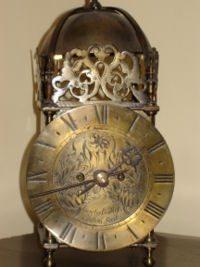
Japanese clock
Encyclopedia
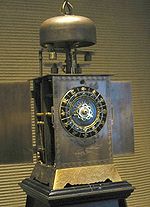
Clock
A clock is an instrument used to indicate, keep, and co-ordinate time. The word clock is derived ultimately from the Celtic words clagan and clocca meaning "bell". A silent instrument missing such a mechanism has traditionally been known as a timepiece...
that has been made to tell traditional Japanese time. Mechanical clocks were introduced into Japan
Japan
Japan is an island nation in East Asia. Located in the Pacific Ocean, it lies to the east of the Sea of Japan, China, North Korea, South Korea and Russia, stretching from the Sea of Okhotsk in the north to the East China Sea and Taiwan in the south...
by Jesuit missionaries
Missionary
A missionary is a member of a religious group sent into an area to do evangelism or ministries of service, such as education, literacy, social justice, health care and economic development. The word "mission" originates from 1598 when the Jesuits sent members abroad, derived from the Latin...
or Dutch
Netherlands
The Netherlands is a constituent country of the Kingdom of the Netherlands, located mainly in North-West Europe and with several islands in the Caribbean. Mainland Netherlands borders the North Sea to the north and west, Belgium to the south, and Germany to the east, and shares maritime borders...
merchants in the sixteenth century. These clocks were of the lantern clock
Lantern clock
A lantern clock is a type of antique weight-driven wall clock, shaped like a lantern. They were the first type of clock widely used in private homes. They probably originated before 1500 but only became common after 1600; in Britain around 1620. They became obsolete in the 19th century.- Origin...
design, typically made of brass
Brass
Brass is an alloy of copper and zinc; the proportions of zinc and copper can be varied to create a range of brasses with varying properties.In comparison, bronze is principally an alloy of copper and tin...
or iron
Iron
Iron is a chemical element with the symbol Fe and atomic number 26. It is a metal in the first transition series. It is the most common element forming the planet Earth as a whole, forming much of Earth's outer and inner core. It is the fourth most common element in the Earth's crust...
, and used the relatively primitive verge and foliot escapement
Escapement
In mechanical watches and clocks, an escapement is a device that transfers energy to the timekeeping element and enables counting the number of oscillations of the timekeeping element...
. Tokugawa Ieyasu
Tokugawa Ieyasu
was the founder and first shogun of the Tokugawa shogunate of Japan , which ruled from the Battle of Sekigahara in 1600 until the Meiji Restoration in 1868. Ieyasu seized power in 1600, received appointment as shogun in 1603, abdicated from office in 1605, but...
owned a lantern clock of European manufacture.
Neither the pendulum
Pendulum
A pendulum is a weight suspended from a pivot so that it can swing freely. When a pendulum is displaced from its resting equilibrium position, it is subject to a restoring force due to gravity that will accelerate it back toward the equilibrium position...
nor the balance spring
Balance spring
A balance spring, or hairspring, is a part used in mechanical timepieces. The balance spring, attached to the balance wheel, controls the speed at which the wheels of the timepiece turn, and thus the rate of movement of the hands...
were in use among European clocks of the period, and as such they were not included among the technologies available to the Japanese clockmakers at the start of the isolationist period
Sakoku
was the foreign relations policy of Japan under which no foreigner could enter nor could any Japanese leave the country on penalty of death. The policy was enacted by the Tokugawa shogunate under Tokugawa Iemitsu through a number of edicts and policies from 1633–39 and remained in effect until...
in Japanese history
History of Japan
The history of Japan encompasses the history of the islands of Japan and the Japanese people, spanning the ancient history of the region to the modern history of Japan as a nation state. Following the last ice age, around 12,000 BC, the rich ecosystem of the Japanese Archipelago fostered human...
, which began in 1641. The isolationist period meant that Japanese clockmakers would have to find their own way without significant further inputs from Western developments in clockmaking. Nevertheless, the Japanese clockmakers showed considerable ingenuity in adapting the European mechanical clock technology to the needs of traditional Japanese timekeeping.
Temporal hours
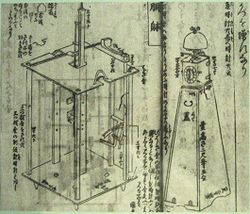
Clockmaker
A clockmaker is an artisan who makes and repairs clocks. Since almost all clocks are now factory-made, most modern clockmakers only repair clocks. Modern clockmakers may be employed by jewellers, antique shops, and places devoted strictly to repairing clocks and watches...
s. Japanese traditional timekeeping practices required the use of unequal temporal
Time
Time is a part of the measuring system used to sequence events, to compare the durations of events and the intervals between them, and to quantify rates of change such as the motions of objects....
hours: six daytime units from local sunrise to local sunset, and six night time units from sunset to sunrise.
As such, Japanese timekeepers varied with the seasons; the daylight hours were longer in summer and shorter in winter, with the opposite at night. European mechanical clocks were, by contrast, set up to tell equal hour
Hour
The hour is a unit of measurement of time. In modern usage, an hour comprises 60 minutes, or 3,600 seconds...
s that did not vary with the seasons.
Most Japanese clocks were driven by weight
Weight
In science and engineering, the weight of an object is the force on the object due to gravity. Its magnitude , often denoted by an italic letter W, is the product of the mass m of the object and the magnitude of the local gravitational acceleration g; thus:...
s. However, the Japanese were also aware of, and occasionally made, clocks that ran from springs
Spring (device)
A spring is an elastic object used to store mechanical energy. Springs are usually made out of spring steel. Small springs can be wound from pre-hardened stock, while larger ones are made from annealed steel and hardened after fabrication...
. Like the Western lantern clocks that inspired their design, the weight driven clocks were often held up by specially built tables or shelves that allowed the weights to drop beneath them. Spring driven Japanese clocks were made for portability; the smallest were the size of large watch
Watch
A watch is a small timepiece, typically worn either on the wrist or attached on a chain and carried in a pocket, with wristwatches being the most common type of watch used today. They evolved in the 17th century from spring powered clocks, which appeared in the 15th century. The first watches were...
es, and carried by their owners in inro
Inro
An is a traditional Japanese case for holding small objects. Because traditional Japanese garb lacked pockets, objects were often carried by hanging them from the obi, or sash. Most types of these sagemono were created for specialized contents, such as tobacco, pipes, writing brush and ink, but...
pouches.
The traditional Japanese time system
The typical clock had six numbered hours from 9 to 4, which counted backwards from noon until midnight; the hour numbers 1 through 3 were not used in Japan for religious reasons, because these numbers of strokes were used by BuddhistsBuddhism
Buddhism is a religion and philosophy encompassing a variety of traditions, beliefs and practices, largely based on teachings attributed to Siddhartha Gautama, commonly known as the Buddha . The Buddha lived and taught in the northeastern Indian subcontinent some time between the 6th and 4th...
to call to prayer. The count ran backwards because the earliest Japanese artificial timekeepers used the burning of incense
Incense
Incense is composed of aromatic biotic materials, which release fragrant smoke when burned. The term "incense" refers to the substance itself, rather than to the odor that it produces. It is used in religious ceremonies, ritual purification, aromatherapy, meditation, for creating a mood, and for...
to count down the time. Dawn and dusk were therefore both marked as the sixth hour in the Japanese timekeeping system.
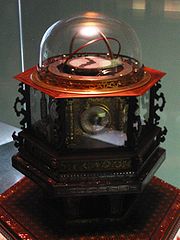
Chinese astrology
Chinese astrology is based on the traditional astronomy and calendars. The development of Chinese astrology is tied to that of astronomy, which came to flourish during the Han Dynasty ....
. Starting at dawn, the six daytime hours were:
| Zodiac sign | Zodiac symbol | Japanese numeral Japanese numerals The system of Japanese numerals is the system of number names used in the Japanese language. The Japanese numerals in writing are entirely based on the Chinese numerals and the grouping of large numbers follow the Chinese tradition of grouping by 10,000... | Strike | Solar time Solar time Solar time is a reckoning of the passage of time based on the Sun's position in the sky. The fundamental unit of solar time is the day. Two types of solar time are apparent solar time and mean solar time .-Introduction:... |
|---|---|---|---|---|
| Hare Rabbit (zodiac) The Chinese Year of the Rabbit is actually the Chinese Year of the Hare, as China has seven native species of hares and no native species of rabbits. The Chinese applied their word for hare to the first rabbits to be taken to China, and the word is now erroneously back-translated into English as... |
卯 | 六 | 6 | sunrise Sunrise Sunrise is the instant at which the upper edge of the Sun appears above the horizon in the east. Sunrise should not be confused with dawn, which is the point at which the sky begins to lighten, some time before the sun itself appears, ending twilight... |
| Dragon Dragon (zodiac) The Dragon , is one of the 12-year cycle of animals which appear in the Chinese zodiac related to the Chinese calendar, and the only animal that is legendary... |
辰 | 五 | 5 | |
| Serpent Snake (zodiac) The Snake is one of the 12-year cycle of animals which appear in the Chinese zodiac related to the Chinese calendar. The Year of the Snake is associated with the earthly branch symbol 巳.-Years and the Five Elements:... |
巳 | 四 | 4 | |
| Horse Horse (zodiac) The Horse is the seventh of the 12 animals which appear in the Chinese zodiac related to the Chinese calendar. The Year of the Horse is associated with the earthly branch symbol 午.- Years and the Five Elements :... |
午 | 九 | 9 | noon Noon Noon is usually defined as 12 o'clock in the daytime. The word noon is also used informally to mean midday regarding the location of the sun not the middle of a persons day. Although this is a time around the middle of the day when people in many countries take a lunch break... |
| Ram Sheep (zodiac) The Goat is the eighth sign of the 12-year cycle of animals which appear in the Chinese zodiac related to the Chinese calendar. The Year of the Goat is associated with the earthly branch symbol 未.- Years and the Five Elements :... |
未 | 八 | 8 | |
| Monkey Monkey (zodiac) The Monkey is the ninth of the 12-year cycle of animals which appear in the Chinese zodiac related to the Chinese calendar. The Year of the Monkey is associated with the earthly branch symbol 申.-Years and the five elements:... |
申 | 七 | 7 |
From dusk, the six nighttime hours were:
| Zodiac sign | Zodiac symbol | Japanese numeral | Strike | Solar time |
|---|---|---|---|---|
| Cock Rooster (zodiac) The Rooster is one of the 12-year cycle of animals which appear in the Chinese zodiac related to the Chinese calendar. The Year of the Rooster is represented by the earthly branch character 酉.- Years and associated Five Elements :... |
酉 | 六 | 6 | sunset Sunset Sunset or sundown is the daily disappearance of the Sun below the horizon in the west as a result of Earth's rotation.The time of sunset is defined in astronomy as the moment the trailing edge of the Sun's disk disappears below the horizon in the west... |
| Dog Dog (zodiac) The Dog is one of the 12-year cycle of animals which appear in the Chinese zodiac related to the Chinese calendar. The Year of the Dog is associated with the earthly branch symbol 戌... |
戌 | 五 | 5 | |
| Boar Pig (zodiac) The Pig , is the last of the 12 animals which appear in the Chinese zodiac. The Year of the Pig is associated with the earthly branch Hai .In Chinese culture, the pig is associated with fertility and virility... |
亥 | 四 | 4 | |
| Rat Rat (zodiac) The Rat is one of the 12-year cycle of animals which appear in the Chinese zodiac related to the Chinese calendar, the Year of the Rat is associated with the earthly branch symbol 子... |
子 | 九 | 9 | midnight Midnight Midnight is the transition time period from one day to the next: the moment when the date changes. In the Roman time system, midnight was halfway between sunset and sunrise, varying according to the seasons.... |
| Ox Ox (zodiac) The Ox is one of the 12-year cycle of animals which appear in the Chinese zodiac related to the Chinese calendar. The Year of the Ox is denoted by the earthly branch character 丑... |
丑 | 八 | 8 | |
| Tiger Tiger (zodiac) The Tiger , is one of the 12-year cycle of animals which appear in the Chinese zodiac related to the Chinese calendar. The Year of the Tiger is associated with the earthly branch symbol 寅.- Years and the Five Elements :... |
寅 | 七 | 7 |
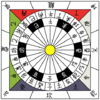
The problem of varying hour lengths
Japanese clocks used various mechanisms to display the changing temporal hours. The most practical way was with a pillar clock, where the clock indicated time not on a clock faceClock face
A clock face is the part of an analog clock that displays the time through the use of a fixed numbered dial or dials and moving hands. In its most basic form, recognized universally throughout the world, the dial is numbered 1–12 indicating the hours in a 12-hour cycle, and a short hour hand...
, but on an indicator attached to a weight that descended in a track. Movable time indicators ran alongside the track of the weight and its attached indicator. These indicators could be adjusted for the seasons to show the length of the day and nighttime hours. When the clock was wound, the indicator was moved back up the track to the appropriate marker. This setup had the advantage of being independent of the rate of the clock itself.
The use of clock faces was part of the European technology received in Japan, and a number of arrangements were made to display Japanese hours on clock faces. Some had movable hours around the rim of a 24 hour clock dial. Others had multiple clock faces that could be changed with the seasons. To make a striking clock
Striking clock
A striking clock is a clock that sounds the hours audibly on a bell or gong. In 12 hour striking, used most commonly in striking clocks today, the clock strikes once at 1 AM, twice at 2 AM, continuing in this way up to twelve times at 12 noon, then starts over, striking once at 1 PM, twice at 2...
that told Japanese time, clockmakers used a system that ran two balances, one slow and one fast. The appropriate escapement was changed automatically as the time moved from day to night. The myriad year clock
Myriad year clock
The , was a universal clock designed by the Japanese inventor Hisashige Tanaka in 1851. It belongs to the category of Japanese clocks called Wadokei. This clock is designated as an Important Cultural Asset by Japanese government....
designed in 1850 by Hisashige Tanaka
Hisashige Tanaka
was a Japanese engineer and inventor during the late Edo and Meiji period Japan. He is one of the founders of what later became Toshiba Corporation. He has been called the "Thomas Edison of Japan" or Karakuri Giemon....
uses this mechanism.
In 1873 the Japanese government adopted Western style timekeeping practices, including equal hours that do not vary with the seasons, and the Gregorian calendar
Gregorian calendar
The Gregorian calendar, also known as the Western calendar, or Christian calendar, is the internationally accepted civil calendar. It was introduced by Pope Gregory XIII, after whom the calendar was named, by a decree signed on 24 February 1582, a papal bull known by its opening words Inter...
.
